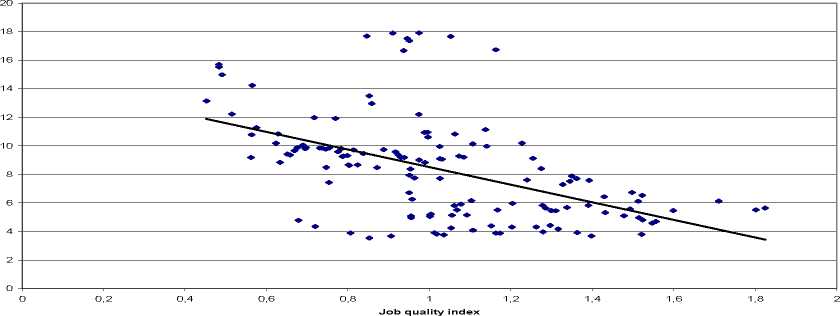Job quality and labour market performance | 9
Figure 6. Job quality index and long-term unemployment rates, EU countries, 1983-2004

Source: LFS 1983-2004, authors’ calculations; one observation corresponds to one year for a given country.
hal-00616771, version 1 - 24 Aug 2011
Figure 7. Job quality index and NAIRU, EU countries, 1995-2004

Source: Eurostat, LFS 1983-2004, authors’ calculations; one observation corresponds to one year for a given country.
These results are consistent with other studies that also display a positive relationship between
quantitative labour market performances and job quality indicators (Leschke and Watt, 2008;
Eurofound, 2008).
4. The heterogeneity of job quality by social groups
The aim of our analysis in this part is to have an overview of disparities in terms of job quality
across age groups, economic activities and education levels. We will then try to see which social
groups are the most affected by low-quality jobs and if these groups are likely to accumulate
bad features in all dimensions of job quality.
Our main focus will be the ‘socio-economic security’ dimension, which mainly includes
indicators on wages and types of work contracts (part-time vs. full-time, temporary vs. long-
term contract). Concerning working conditions it appears to be more difficult to break down
data by criteria of age, gender, activity etc. as they generally stem from rather small samples
(1000 individuals per country in the Fourth European Working Conditions Survey). Yet
Eurostat’s Labour Force Survey data on asocial working hours is available at finer levels and
More intriguing information
1. Can a Robot Hear Music? Can a Robot Dance? Can a Robot Tell What it Knows or Intends to Do? Can it Feel Pride or Shame in Company?2. AN ANALYTICAL METHOD TO CALCULATE THE ERGODIC AND DIFFERENCE MATRICES OF THE DISCOUNTED MARKOV DECISION PROCESSES
3. The name is absent
4. The name is absent
5. Crime as a Social Cost of Poverty and Inequality: A Review Focusing on Developing Countries
6. Input-Output Analysis, Linear Programming and Modified Multipliers
7. Types of Cost in Inductive Concept Learning
8. Cyber-pharmacies and emerging concerns on marketing drugs Online
9. Trade Liberalization, Firm Performance and Labour Market Outcomes in the Developing World: What Can We Learn from Micro-LevelData?
10. An Efficient Secure Multimodal Biometric Fusion Using Palmprint and Face Image